武汉大学英语专业考研MTI真题
- 格式:doc
- 大小:79.50 KB
- 文档页数:11
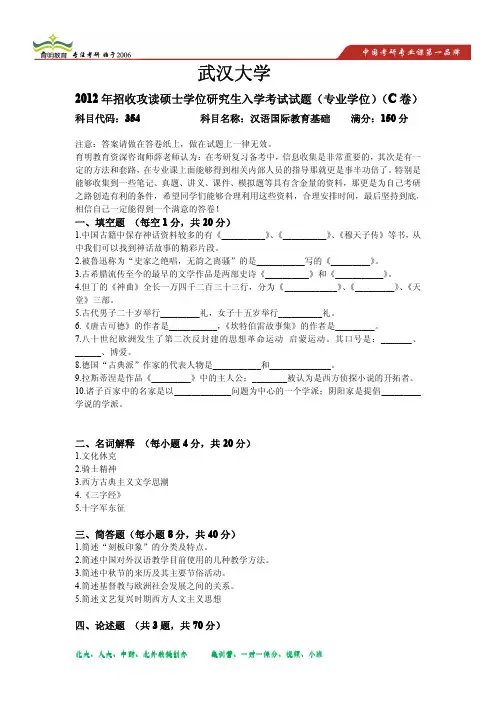
武汉大学2012年招收攻读硕士学位研究生入学考试试题(专业学位)(C卷)科目代码:354科目名称:汉语国际教育基础满分:150分注意:答案请做在答卷纸上,做在试题上一律无效。
育明教育资深咨询师薛老师认为:在考研复习备考中,信息收集是非常重要的,其次是有一定的方法和套路,在专业课上面能够得到相关内部人员的指导那就更是事半功倍了。
特别是能够收集到一些笔记、真题、讲义、课件、模拟题等具有含金量的资料,那更是为自己考研之路创造有利的条件,希望同学们能够合理利用这些资料,合理安排时间,最后坚持到底,相信自己一定能得到一个满意的答卷!一、填空题(每空1分,共20分)1.中国古籍中保存神话资料较多的有《__________》、《__________》、《穆天子传》等书,从中我们可以找到神话故事的精彩片段。
2.被鲁迅称为“史家之绝唱,无韵之离骚”的是___________写的《_________》。
3.古希腊流传至今的最早的文学作品是两部史诗《__________》和《___________》。
4.但丁的《神曲》全长一万四千二百三十三行,分为《____________》、《_________》、《天堂》三部。
5.古代男子二十岁举行_________礼,女子十五岁举行__________礼。
6.《唐吉可德》的作者是___________,《坎特伯雷故事集》的作者是_________。
7.八十世纪欧洲发生了第二次反封建的思想革命运动启蒙运动。
其口号是:_______、______、博爱。
8.德国“古典派”作家的代表人物是___________和______________。
9.拉斯蒂涅是作品《_________》中的主人公;________被认为是西方侦探小说的开拓者。
10.诸子百家中的名家是以_____________问题为中心的一个学派;阴阳家是提倡_________学说的学派。
二、名词解释(每小题4分,共20分)1.文化休克2.骑士精神3.西方古典主义文学思潮4.《三字经》5.十字军东征三、简答题(每小题8分,共40分)1.简述“刻板印象”的分类及特点。
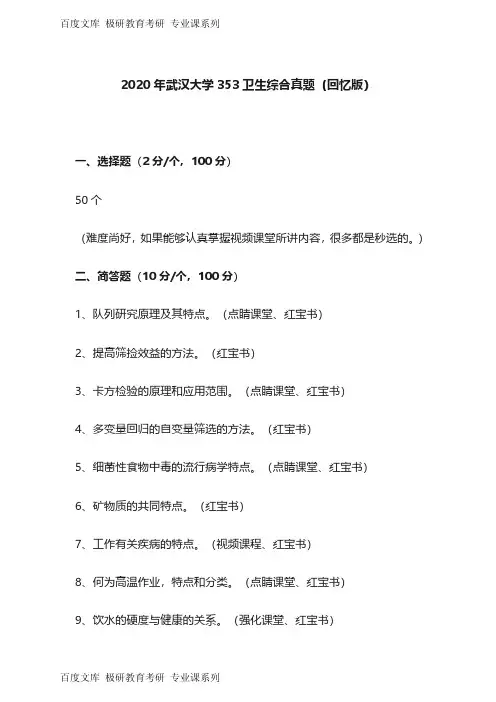
2020年武汉大学353卫生综合真题(回忆版)一、选择题(2分/个,100分)50个(难度尚好,如果能够认真掌握视频课堂所讲内容,很多都是秒选的。
)二、简答题(10分/个,100分)1、队列研究原理及其特点。
(点睛课堂、红宝书)2、提高筛捡效益的方法。
(红宝书)3、卡方检验的原理和应用范围。
(点睛课堂、红宝书)4、多变量回归的自变量筛选的方法。
(红宝书)5、细菌性食物中毒的流行病学特点。
(点睛课堂、红宝书)6、矿物质的共同特点。
(红宝书)7、工作有关疾病的特点。
(视频课程、红宝书)8、何为高温作业,特点和分类。
(点睛课堂、红宝书)9、饮水的硬度与健康的关系。
(强化课堂、红宝书)10、室内污染的来源。
(点睛课堂、红宝书)(难度尚好,均在研习社所处的红宝书/视频课堂中找到原题或者类似题目。
)三、论述题(20分/个,100分)1、关于肺癌的数据,计算RR AR PAR ARP PARP五个指标并解释意义。
(点睛课堂、红宝书)暴露组51/10万,c对照5/10万,人群21/10万。
2、方差分析(完全随机设计方差分析的检验具体步骤)。
(点睛课堂、红宝书、最后的压题文件!)总变异490,组间变异120,一共40个人,三组降血压药物对高血压病人的影响有啥区别,第一问数据类型,第二问是什么设计,第三问做假设检验,需要画个方差分析表,给了F的一个表格找F进行比较。
3、膳食因素和动脉粥样硬化的关系。
(强化课堂、红宝书)4、生产性毒物进入体内的途径,影响毒物毒作用的因素。
(点睛课堂、红宝书)5、富营养化的形成,危害,防止措施。
(点睛课堂、红宝书)(难度尚好,均在研习社所处的红宝书/视频课堂中找到原题或者类似题目。
)小P班班对353卫生综合的总体评价(一)整体难度整体难度中等。
流行病和统计都在重点范围内,三大卫部分也都在教材范围内。
(二)题型和题量是否变化?题型没有改变,但是选择题由100道减为50道,简答题由5道增加至10道。
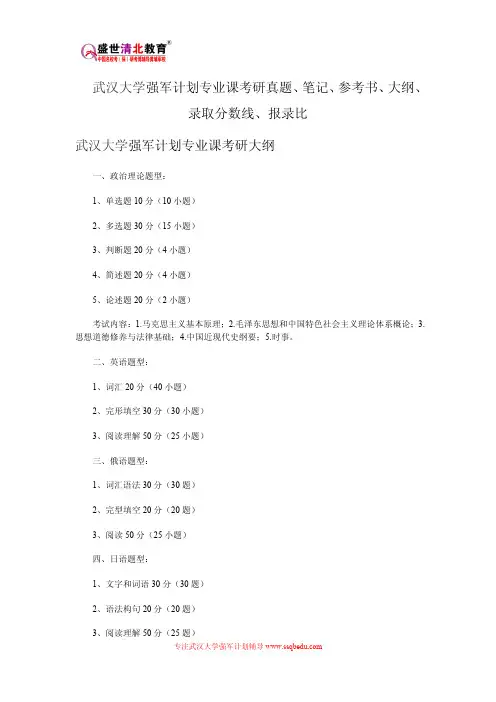
武汉大学强军计划专业课考研真题、笔记、参考书、大纲、
录取分数线、报录比
武汉大学强军计划专业课考研大纲
一、政治理论题型:
1、单选题10分(10小题)
2、多选题30分(15小题)
3、判断题20分(4小题)
4、简述题20分(4小题)
5、论述题20分(2小题)
考试内容:1.马克思主义基本原理;2.毛泽东思想和中国特色社会主义理论体系概论;3.思想道德修养与法律基础;4.中国近现代史纲要;5.时事。
二、英语题型:
1、词汇20分(40小题)
2、完形填空30分(30小题)
3、阅读理解50分(25小题)
三、俄语题型:
1、词汇语法30分(30题)
2、完型填空20分(20题)
3、阅读50分(25小题)
四、日语题型:
1、文字和词语30分(30题)
2、语法构句20分(20题)
3、阅读理解50分(25题)
五、数学题型:
1、填空题25分(5小题)
2、单选题25分(5小题)
3、计算题100分(10小题)
考试内容:高等数学:1、函数与极限;2、导数与微分;3、中值定理与导数应用;4、不定积分;5、定积分;6、定积分应用;7、空间解析几何;8、多元函数微分法及其应用;
9、重积分;10、曲线积分与曲面积分;11、无穷级数;12、常微分方程。
六、专业课考试科目
专业课考试科目与统考研究生专业课考试科目相同,请参考《哈尔滨工程大学2015年硕士研究生招生专业目录》和《哈尔滨工程大学2015年硕士研究生入学考试专业课考试大纲》。

武汉大学考研——新闻与传播考研经历看过很多经验贴,有很多会讲自己的经历什么的,其实大可不必,最多只是当个故事瞧,每个人的备考过程都会因为环境、心境的不同而有区别,因此也会做出不同的选择。
考研和就业没有绝对的孰好孰坏,跟着自己的内心走,每一个选择都会是最好的选择。
在这里,首先必须感谢high研当初的陪伴与支持,如果没有它,可能就不会成就现在的我。
在我最迷茫最无措的时候,是high研给我指明了方向,才会让我成功上岸。
所以,我想把我的考研之路写下来,给学弟学妹一个参考,希望大家都能得偿所愿,去到自己理想的院校。
(high研还给了非常优厚的稿费,两全其美。
嘿嘿),希望你们也能像我当初一样,迷茫了就来这里看看,或许我的些许经验真的对你的复习有所帮助呢。
下面,言归正传。
首先说一下我的基本情况,本科双非,三跨,二战。
一战武大,因专业课成绩差而败北,二战的时候改变策略,重专业,轻政英,最终成绩也符合二战规划,政英成绩基本没有变化,而两门专业课成绩总共提升了18分。
综合两次备考,现将经历整理如下:1.政治今年政治大题分数较高,拿到了38分。
全凭自学,身边有好多同学去报了考研班,但是,奉劝各位研友千万不要把考研机构的指导经验当作圣经来膜拜,只能仅供参考!政治资料我主要是跟的肖秀荣老师。
资料:政治大纲、风中劲草、《政治新时器》、肖秀荣1000题,肖秀荣时政,最后市面上所有的押题卷我都有买,9月份:刷肖秀荣1000题(做两遍),弄清错题,主要是针对选择题。
10月份:开始背风中劲草,抛开哲学,风中劲草我来回背了很多遍,一直背到考前。
按照框架进行。
11月份:开始进行做押题卷,市面上有各种押题卷,我全买来做了,主要是针对选择题,因为选择题的体型很新,必须要做到融会贯通,虽然我最后还是死在了选择题上,但是今年的选择题还是比较难的,我能上七十已经很满意了。
12月份:开始做主观题,背肖八肖四以及老蒋的五套卷。
然后跟了老蒋的网课。
其实大题只要踏踏实实的背,30分不会少,最后我的大题达到了38分,我还是很意外的。
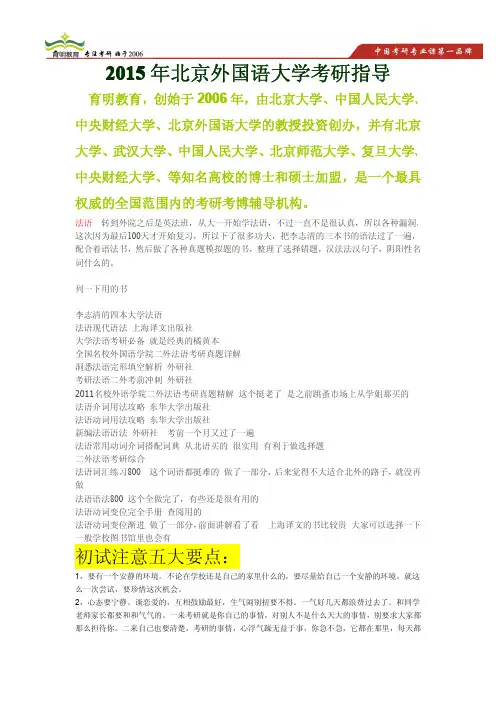
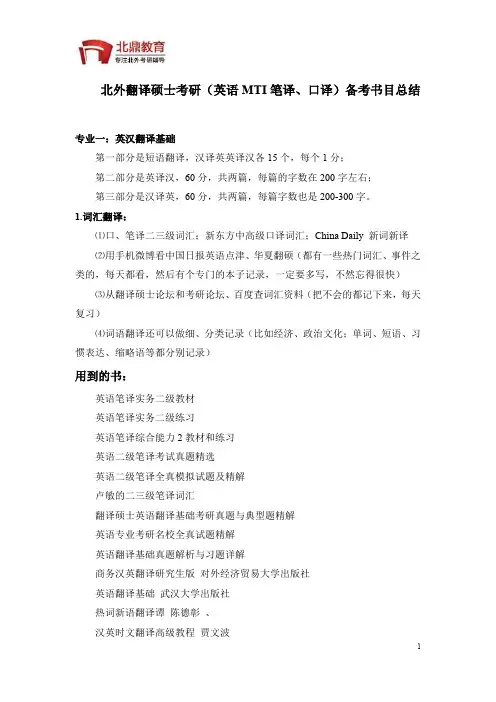
北外翻译硕士考研(英语MTI笔译、口译)备考书目总结专业一:英汉翻译基础第一部分是短语翻译,汉译英英译汉各15个,每个1分;第二部分是英译汉,60分,共两篇,每篇的字数在200字左右;第三部分是汉译英,60分,共两篇,每篇字数也是200-300字。
1.词汇翻译:⑴口、笔译二三级词汇;新东方中高级口译词汇;China Daily 新词新译⑵用手机微博看中国日报英语点津、华夏翻硕(都有一些热门词汇、事件之类的,每天都看,然后有个专门的本子记录,一定要多写,不然忘得很快)⑶从翻译硕士论坛和考研论坛、百度查词汇资料(把不会的都记下来,每天复习)⑷词语翻译还可以做细、分类记录(比如经济、政治文化;单词、短语、习惯表达、缩略语等都分别记录)用到的书:英语笔译实务二级教材英语笔译实务二级练习英语笔译综合能力2教材和练习英语二级笔译考试真题精选英语二级笔译全真模拟试题及精解卢敏的二三级笔译词汇翻译硕士英语翻译基础考研真题与典型题精解英语专业考研名校全真试题精解英语翻译基础真题解析与习题详解商务汉英翻译研究生版对外经济贸易大学出版社英语翻译基础武汉大学出版社热词新语翻译谭陈德彰、汉英时文翻译高级教程贾文波非文学翻译理论与实践李长栓新版非文学翻译李长栓大学英汉翻译教程王志奎新东方中高口口试考试词汇必备最新汉英特色词汇词典汉语报刊超in新词英译例话中式英语之鉴同传的参考书目新闻英语分类词典外研社汉英翻译基础陈宏薇英美文化与汉英翻译汪福祥突破词汇20000翻译硕士考研白皮书学习网站英语学习、新东方英语杂志、可可英语网、普特、政府工作报告2.段落翻译:(需要大量的输入)经济学人、英语世界、英语文摘(单词、短语、知识点、好句子都记下来,关键要有浸泡式的感觉)写作:专八经典美文(外文社出版)专业二:汉语写作与百科知识1.名词解释:文化类、时事类较多,可以有侧重。
【1.参考书上的词条全部整理下来;2.考研论坛以前的各种帖子上许多学校的回忆贴打下来进行词条总结;3.用手机看互动百科的知识版块,不熟悉的可以记下来。
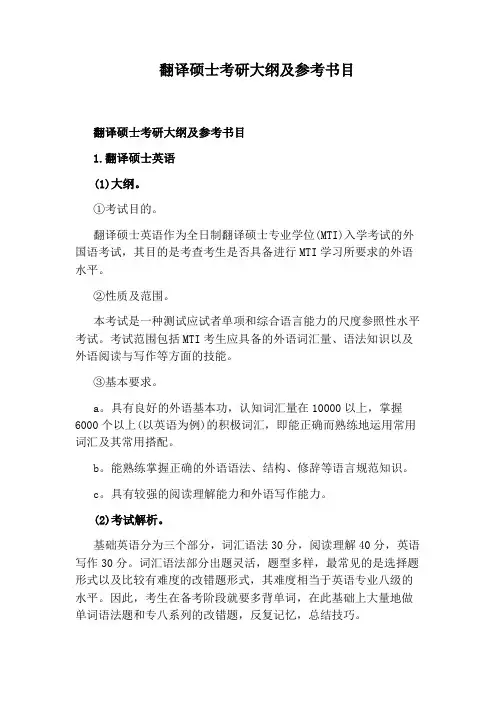
翻译硕士考研大纲及参考书目翻译硕士考研大纲及参考书目1.翻译硕士英语(1)大纲。
①考试目的。
翻译硕士英语作为全日制翻译硕士专业学位(MTI)入学考试的外国语考试,其目的是考查考生是否具备进行MTI学习所要求的外语水平。
②性质及范围。
本考试是一种测试应试者单项和综合语言能力的尺度参照性水平考试。
考试范围包括MTI考生应具备的外语词汇量、语法知识以及外语阅读与写作等方面的技能。
③基本要求。
a。
具有良好的外语基本功,认知词汇量在10000以上,掌握6000个以上(以英语为例)的积极词汇,即能正确而熟练地运用常用词汇及其常用搭配。
b。
能熟练掌握正确的外语语法、结构、修辞等语言规范知识。
c。
具有较强的阅读理解能力和外语写作能力。
(2)考试解析。
基础英语分为三个部分,词汇语法30分,阅读理解40分,英语写作30分。
词汇语法部分出题灵活,题型多样,最常见的是选择题形式以及比较有难度的改错题形式,其难度相当于英语专业八级的水平。
因此,考生在备考阶段就要多背单词,在此基础上大量地做单词语法题和专八系列的改错题,反复记忆,总结技巧。
阅读理解部分,传统选择题的难度大致为专八水平,但也可能出现GRE水平的理解题,而对于一些非传统的阅读题型,比如paraphrase,answerquestions等,考查的不仅是阅读能力和理解能力,也在一定程度上考查考生的表达能力。
所以,在平时做阅读理解题的过程中,考生要有意识地强化自己的语言“输出”能力,不可词不达意。
英语写作部分类似于专八水平,但有的学校可能为更突出时效性,会考一些时事文题。
考生在平时要多写、多练、多积累、多揣摩、多思考,不可一味地求数量而忽视每一篇的质量。
(3)参考书目。
①姜桂华。
中式英语之鉴[M]。
北京:外语教学与研究出版社,2000.②张汉熙。
高级英语[M]。
北京:外语教学与研究出版社,1995.③蒋显璟。
英美散文选读[M]。
北京:对外经贸大学出版社,2008.④谭载喜。
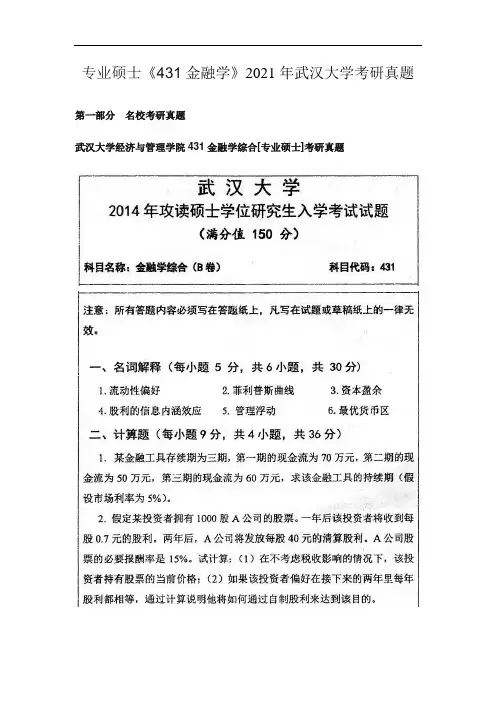
专业硕士《431金融学》2021年武汉大学考研真题第一部分名校考研真题武汉大学经济与管理学院431金融学综合[专业硕士]考研真题武汉大学经济与管理学院431金融学综合[专业硕士]考研真题及详解一、名词解释(每小题5分,共6小题,共30分)1流动性偏好答:流动性偏好是指由于货币具有使用上的灵活性,人们宁肯以牺牲利息收入而储存不生息的货币来保持财富的心理倾向。
人们如果以货币以外的其他形式来持有财富,会带来收益,例如,以债券形式持有,会有利息收入;以股票形式持有,会有股息或红利收入;以房产形式持有,会有租金收入等等。
与任何商品和有价证券相比,货币的流动性都是最高的。
按照凯恩斯的观点,人们储存货币是出于三种动机:①交易动机,指个人和企业为了进行正常的交易活动而持有一部分货币的动机,出于交易动机的货币需求量主要决定于收入;②②预防性动机,指为预防意外支出而持有一部分货币的动机,也是收入的函数;③③投机动机,指人们为了抓住有利的购买有价证券的机会而持有一部分货币的动机,货币投机需求与利率变动有负向关系。
2菲利普斯曲线答:菲利普斯曲线是由英国经济学家菲利普斯根据1861~1957年英国的失业率和货币工资变动率的经验统计资料提出来的,用以说明失业率和货币工资率之间交替变动关系的一条曲线。
因为西方经济学家认为,货币工资率的提高是引起通货膨胀的原因,即货币工资率的增加超过劳动生产率的增加会引起物价上涨,从而导致通货膨胀。
所以,菲利普斯曲线又成为当代经济学家用以表示失业率和通货膨胀率之间此消彼长、相互交替关系的曲线。
其含义为:失业率高,通胀率就低;失业率低,通胀率就高,并认为二者间这种关系可为政府进行总需求管理提供一份可供选择的菜单,即通胀率或失业率太高时,可用提高失业率的紧缩政策或提高通胀率的扩张政策来降低通胀率或降低失业率,以免经济剧烈波动。
菲利普斯曲线可用图1说明。
图1菲利普斯曲线图1中,W为货币工资变动率,U为社会的失业率,L即为菲利普斯曲线。
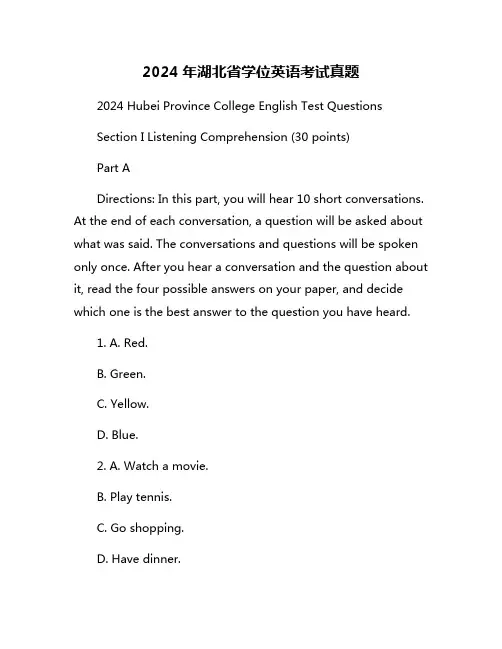
2024年湖北省学位英语考试真题2024 Hubei Province College English Test QuestionsSection I Listening Comprehension (30 points)Part ADirections: In this part, you will hear 10 short conversations. At the end of each conversation, a question will be asked about what was said. The conversations and questions will be spoken only once. After you hear a conversation and the question about it, read the four possible answers on your paper, and decide which one is the best answer to the question you have heard.1. A. Red.B. Green.C. Yellow.D. Blue.2. A. Watch a movie.B. Play tennis.C. Go shopping.D. Have dinner.3. A. At 8:00.B. At 8:15.C. At 8:30.D. At 9:00.4. A. In a bank.B. At a post office.C. In a supermarket.D. At a library.5. A. Engineer and secretary.B. Doctor and patient.C. Teacher and student.D. Father and daughter.6. A. In a restaurant.B. At a hotel.C. At a library.D. In a park.7. A. Watch a movie.B. Play basketball.C. Go swimming.D. Listen to music.8. A. Three.B. Four.C. Five.D. Six.9. A. Monday.B. Tuesday.C. Wednesday.D. Thursday.10. A. Tom is Tina’s best friend.B. Tom is Tina’s cousin.C. Tom is Tina’s brother.D. Tom is Tina’s father.Part BDirections: In this part, you will hear 3 short passages. At the end of each passage, you will hear some questions. The passages and questions will be spoken only once. After you hear a question, read the four possible answers on your paper, and decide which one is the best answer to the question you have heard.Passage One11. A. He is a musician.B. He is an artist.C. He is an athlete.D. He is a writer.12. A. 200 kilometers per hour.B. 300 kilometers per hour.C. 400 kilometers per hour.D. 500 kilometers per hour.13. A. France.B. Germany.C. Italy.D. The United Kingdom. Passage Two14. A. His father.B. His mother.C. His teacher.D. His friend.15. A. Once a week.B. Twice a week.C. Four times a week.D. Every day.16. A. By car.B. By bike.C. By bus.D. On foot.Passage Three17. A. At a travel agency.B. At a library.C. At a bank.D. At a post office.18. A. 20 minutes.B. 30 minutes.C. 40 minutes.D. 50 minutes.19. A. Next Sunday.B. This Sunday.C. Tomorrow.D. The day after tomorrow.Section II Use of English (30 points)Directions: Read the following text. Choose the best word (s) for each blank and mark A, B, C or D on your answer sheet.Traveling AbroadMany people dream of (20)______ abroad for fun or work. When we travel to a place where the people speak a different language, we may feel worried about not being able to communicate with others. However, knowing a (21)______ wordsand phrases in the local language can make things easier. (22)______ words such as “hello,” “please,” and “thank you” can (23)______ a big difference. Don’t be afraid to use body language and gestures to help get your message across.To (24)______ a foreign country, it’s also essential to do some research before you go. Find out about the local culture, customs, and traditions. This (25)______ help you avoid making mistakes that could offend the locals. Also, take time to learn about the history and landmarks of the country you’re visiting. It can make your trip (26)______ more enjoyable and meaningful.Traveling can also be a great way to (27)______ new things. Whether it’s trying new foods, experiencing different art forms, or learning about the history of a place, traveling can (28)______ you to think and see things in new ways. It’s a wonderful opportunity to step outside your comfort zone, (29)______ your horizons, and make memories that will last a lifetime.(30)______ you are traveling for leisure or work, remember that the journey is just as important as the destination. Embrace the experience, enjoy the moments, and have fun exploring the world.20. A. to travelC. traveledD. traveling21. A. smallB. fewC. littleD. some22. A. UnderstandingB. KnowingC. LearningD. Teaching23. A. makeB. haveC. doD. be24. A. enjoyB. journeyD. drive25. A. mustB. canC. shouldD. may26. A. evenB. muchC. quiteD. very27. A. knowledgeB. understandC. experienceD. realize28. A. guideB. leadC. drive29. A. extendingB. wideningC. openingD. stretching30. A. WhetherB. WhateverC. WheneverD. WhereverSection III Reading Comprehension (40 points)Part ADirections: Read the following passage. Answer the questions according to the information given in the passage.The Two Sides of TechnologyTechnology has become an integral part of our daily lives. It affects the way we communicate, work, and even think. However, while technology offers many benefits, it also comes with drawbacks.On the positive side, technology has made communication more accessible and efficient. With the use of smartphones and social media, people can connect with others around the world instantly. This has brought people closer together and allowed for greater collaboration and sharing of ideas.In the workplace, technology has revolutionized the way we work. Tasks that used to take days or weeks to complete can now be done in a matter of hours. This increase in productivity has led to economic growth and innovation in many industries.However, technology also has its downsides. One of the biggest concerns is the impact of technology on our mental and physical health. Excessive screen time can lead to eye strain, headaches, and sleep disturbances. Moreover, constant connectivity can lead to feelings of stress and anxiety as people struggle to disconnect from work and social media.Another drawback of technology is its impact on social relationships. While technology has made it easier to communicate with others, it has also made face-to-face interactions less common. This can lead to feelings of loneliness and isolation, as people spend more time interacting with screens than with each other.In conclusion, technology is a double-edged sword. While it offers many benefits and conveniences, it also has its downsides. It is important for individuals to be mindful of the negative effects of technology and to find a balance between using technology and engaging in real-world interactions.31. What has technology revolutionized in the workplace?32. How has technology affected social relationships?33. According to the passage, what are the drawbacks of technology on mental and physical health?34. What does the author suggest individuals do to find a balance with technology?Part BDirections: Read the following passage. Answer the questions according to the information given in the passage.The Benefits of Learning a Second LanguageLearning a second language has numerous benefits that extend beyond just being able to communicate with speakers of that language. Studies have shown that bilingual individuals have improved cognitive skills, such as better problem-solving abilities and enhanced creativity. This is because learning asecond language requires the brain to think in different ways and adapt to new linguistic structures.In addition, learning a second language can open up new opportunities for travel, work, and personal growth. Being able to speak a second language can give individuals a competitive advantage in the job market and increase their earning potential. It can also allow individuals to connect with people from different cultures and gain a deeper understanding of the world.Furthermore, learning a second language can improve overall language skills, including grammar, vocabulary, and pronunciation. It can also enhance communication skills, such as listening, speaking, and writing. These improvements in language proficiency can benefit individuals in their personal and professional lives.Overall, learning a second language is a valuable skill that can offer a wide range of benefits. It can stimulate the brain, increase job opportunities, and enhance communication skills. It is a rewarding experience that can lead to personal growth and enrich individuals’ lives in many ways.35. What cognitive skills do bilingual individuals have?36. How can learning a second language benefit individuals in the job market?37. What language skills can be improved by learning a second language?38. What are the benefits of learning a second language according to the passage?Section IV Writing (20 points)Directions: For this part, you are allowed 30 minutes to write a composition on the topic “The Impact of Social Media on Society”. You should write at least 150 words and base your composition on the outline below:1. The popularity of social media in today’s society.2. The positive impacts of social media on individuals and society.3. The negative impacts of social media on individuals and society.4. Your opinion on how to balance the positive and negative impacts of social media.以上是2024年湖北省学位英语考试的真题,希望考生们能够顺利应对考试。
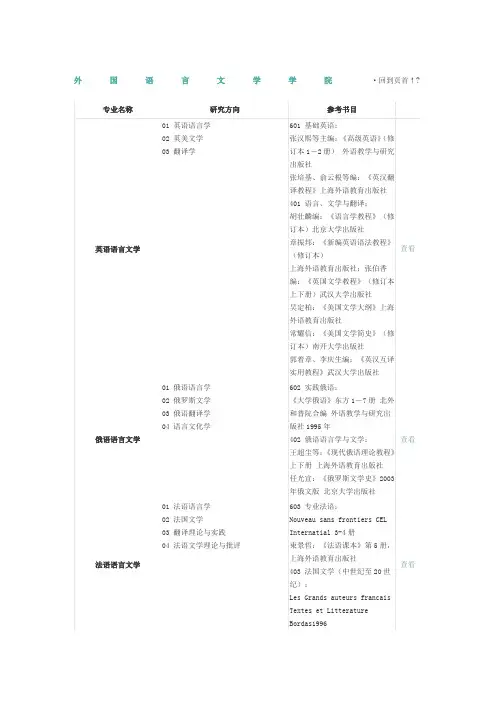
外国语言文学学院·回到页首↑?专业名称研究方向参考书目英语语言文学01 英语语言学02 英美文学03 翻译学601 基础英语:张汉熙等主编:《高级英语》(修订本1-2册)外语教学与研究出版社张培基、俞云根等编:《英汉翻译教程》上海外语教育出版社401 语言、文学与翻译:胡壮麟编:《语言学教程》(修订本)北京大学出版社章振邦:《新编英语语法教程》(修订本)上海外语教育出版社;张伯香编:《英国文学教程》(修订本上下册)武汉大学出版社吴定柏:《美国文学大纲》上海外语教育出版社常耀信:《美国文学简史》(修订本)南开大学出版社郭着章、李庆生编:《英汉互译实用教程》武汉大学出版社查看俄语语言文学01 俄语语言学02 俄罗斯文学03 俄语翻译学04 语言文化学602 实践俄语:《大学俄语》东方1-7册北外和普院合编外语教学与研究出版社1995年402 俄语语言学与文学:王超尘等:《现代俄语理论教程》上下册上海外语教育出版社任光宣:《俄罗斯文学史》2003年俄文版北京大学出版社查看法语语言文学01 法语语言学02 法国文学03 翻译理论与实践04 法语文学理论与批评603 专业法语:Nouveau sans frontiers CELInternatial 3-4册束景哲:《法语课本》第5册,上海外语教育出版社403 法国文学(中世纪至20世纪):Les Grands auteurs francaisTextes et LitteratureBordas1996查看陈振尧:《法国文学史》外语教学与研究出版社德语语言文学01 德语语言学02 德语文学03 翻译学604 基础德语:梁敏等:《德语教程》1-4册北京大学出版社联邦德国驻北京使馆:《德国概况》张才尧:《实用德语语法》外语教学与研究出版社404 德语语言学与文学:韩万衡:《德语语言专题》天津外语大学出版社孙坤荣:《德国文学选读》北京大学出版社余匡复:《德国文学史》上海外语教育出版社杨寿国等:《德汉翻译教程》上海外语教育出版社W.Koller:Einfuerung in dieUebersetzungswissenschaft,Quelle & Meyer, 4.Auflage,Heidelberg1992查看日语语言文学01 日本语言学02 日本文学03 翻译学605 专业日语与翻译:王宣琦:《日本语》(日语中、高学年用教材)武汉大学出版社陈岩:《日汉翻译教程》大连理工大学出版社405 日本概况与写作:吴鲁鄂、张杭萍:《美丽的岛国—日本》武汉大学出版社《日本文学史》(任何日文版本)吴鲁鄂《日本近现代文学作品选读》(2006年日文版)武汉大学出版社《日本国家概况》南开大学出版社查看外国语言学及应用语言学01 应用语言学02 第二语言习得03 语用学及社会语言学601 基础英语:张汉熙等主编:《高级英语》(修订本1-2册)外语教学与研究出版社张培基、俞云根等编:《英汉翻译教程》上海外语教育出版社406 语言学基础:胡壮麟编:《语言学教程》(修查看新闻与传播学院·回到页首↑?专业名称研究方向参考书目新闻学01 新闻理论02 新闻业务03 新闻发展史04 中西新闻比较606 综合知识(含法律、经济、中国文学知识及基础写作): 《法律基础》周叶中主编,武汉大学出版社《当代世界经济与政治》吕有志、戴德铮主编,高等教育出版社《大学语文》徐绍建主编 武汉大学出版社 407 新闻学基础:《理论新闻传播学导论》童兵 人大出版社《新闻理论纲要》李卓钧 武大出版社查看传播学01 传播理论 02 广告传播 03 广播电视传播 04 网络传播 05 图像与动画设计 06 媒介经营管理606 综合知识(含法律、经济、中国文学知识及基础写作): 《法律基础》周叶中主编 武汉大学出版社《当代世界经济与政治》吕有志、戴德铮主编 高等教育出版社《大学语文》徐绍建主编 武汉大学出版社 408 传播学概论:《传播学教程》郭庆光 人大出版社《传播学引论》李彬 新华出版社 《批判视野中的当代西方传播思想研究》石义彬 武汉大学出版社查看信息管理学院·回到页首↑?07 项目管理08 网络管理与网络营销版社2005★电子商务01 电子商务理论02 电子商务管理03 电子商务技术410 电子商务综合(含电子商务概论、数据库原理与应用):《信息资源数据库》周宁武汉大学出版社2006年《电子商务概论》张李义武汉大学出版社2002年查看图书馆学01 图书馆学基础理论与图书馆管理研究02 现代目录学研究03 知识组织与知识管理研究04 信息资源建设与服务研究05 信息检索与咨询研究06 文献与出版研究07 信息资源与知识产权管理08 数字图书馆技术与管理607 文献信息管理(含信息管理学基础、档案管理学、图书馆学基础):《信息管理学基础》马费成等着武汉大学出版社2000年版《图书馆学基础教程》王子舟着武汉大学出版社2003年版或者档案管理学以及图书馆学基础的相关同类教材均可411 信息组织与检索(含文献分类学、目录学、网络信息检索与利用):《文献分类学》俞君立陈树年主编武汉大学出版社2001年版《目录学》彭斐章等编着武汉大学出版社2003年版《网络信息的检索与利用》黄如花编着武汉大学出版社2002年版查看情报学01 情报学理论与方法02 信息管理与知识管理03 信息经济与网络经济04 信息组织与检索05 信息系统工程06 竞争情报与管理咨询07 信息服务与信息保障412 信息管理基础(含信息管理学、数据库原理):《信息管理学基础》马费成武汉大学出版社2002《信息资源数据库》(第二版)周宁武汉大学出版社2006查看档案学01 档案学基础理论与方法研究02 文件管理与档案管理研究03 政府信息化与电子文件管理04 政府信息资源管理法规与政策05 政务信息资源管理研究06 档案信息计算机管理研究07 档案文献遗产保护607 文献信息管理(含信息管理学基础、档案管理学、图书馆学基础):《信息管理学基础》马费成等着武汉大学出版社2000年版《图书馆学基础教程》王子舟着武汉大学出版社2003年版或者档案管理学以及图书馆学基础的相关同类教材均可查看413 档案学基础(含档案学基础、文书学与电子文件管理): 档案学基础、文书学与电子文件管理的同类教材均可★出版发行学01 出版基础理论与管理 02 编辑理论与实践 03 数字出版研究 04 出版营销研究 05 出版管理研究06 出版经济研究 07 期刊研究 08 版权研究 09 国外出版业研究 10 出版史与出版文化研究608 出版发行学:《出版学基础》罗紫初等 山西人民出版社2005《图书学新论》吴平 山西经济出版社1998414 图书营销与管理: 《图书营销学》方卿等 山西经济出版社1998《书业法律基础》黄先蓉 山西经济出版社2001《现代书业企业管理学》朱静雯主编 苏州大学出版社2003查看★信息资源管理01 信息资源规划与配置 02 企业信息资源管理03 电子政务与政府信息资源管理 04 知识产权管理 05 信息服务管理06 信息系统开发与管理 07 信息构建 08 法商信息资源管理 09 信息资源计量研究609 信息组织与信息分析(含信息组织、信息分析与预测): 《信息组织》(第二版)周宁 武汉大学出版社2004《信息分析与预测》查先进 武汉大学出版社2000412 信息管理基础(含信息管理学、数据库原理):《信息管理学基础》马费成 武汉大学出版社2002《信息资源数据库》(第二版)周宁 武汉大学出版社2006查看经济与管理学院·回到页首↑?★金融工程416 宏微观经济学:美曼昆着,梁小民泽:《经济学原理》(上、下册)北京大学出版社1999年版高鸿业主编:《西方经济学》(微观部分)《西方经济学》(宏观部分)第三版,中国人民大学出版社2004年版查看管理科学与工程01 管理科学理论与方法02 项目管理03 投融资管理04 建设工程管理05 系统安全与系统优化06 知识管理与技术创新07 信息技术与物流管理08 变革管理与领导科学09 工业工程与管理417运筹学与技术经济学:龙子泉主编:《管理运筹学》武汉大学出版社(线性规划和决策分析部分)徐莉主编:《技术经济学》武汉大学出版社查看会计学01 财务会计02 管理会计03 审计04 财务管理05 电算化会计418 工商管理基本理论:谭力文、徐珊、李燕萍编着:《管理学》武汉大学出版社2005年版格里高利·曼昆着:《经济学原理》(微观经济学部分)机械工业出版社2003年版查看企业管理01 企业经营管理02 人力资源管理03 生产管理04 物流管理05 民营企业管理418 工商管理基本理论:谭力文、徐珊、李燕萍编着:《管理学》武汉大学出版社2005年版格里高利·曼昆着:《经济学原理》(微观经济学部分)机械工业出版社2003年版查看旅游管理418 工商管理基本理论:谭力文、徐珊、李燕萍编着:《管理学》武汉大学出版社2005年版格里高利·曼昆着:《经济学原理》(微观经济学部分)机械工业出版社2003年版查看技术经济及管理01 管理决策与智能信息处理02 数据、模型、决策分析03 投融资与项目管理04 信息技术与管理变革05 供应链物流管理418 工商管理基本理论:谭力文、徐珊、李燕萍编着:《管理学》武汉大学出版社2005年版格里高利·曼昆着:《经济学原查看法学院·回到页首↑?2003年版《刑法学》(上、下)高铭暄、马克昌主编;中国法制出版社1999年版《刑法学》高铭暄、马克昌主编,北京大学出版社、高等教育出版社2000年版《刑事诉讼法学》徐静村主编,法律出版社1997年版《刑事诉讼法学》陈光中、徐静村主编,中国政法大学出版社1999年版《刑事诉讼法学》樊崇义主编,中国政法大学出版社1998年版民商法学01 民商法学02 外国与比较民商法424 民商法学:《民法原论》马俊驹、余延满着,法律出版社2005年第二版《民法学》郑立、王作堂主编,北京大学出版社1995年版《比较民法学》李双元、温世扬主编,武汉大学出版社1995年版《担保法》陈本寒主编,武汉大学出版社1997年版《合同法原论》余延满着,武汉大学出版社1999年版《商法学》覃有土主编,中国政法大学出版社2000年版《商法学》赵万一主编,中国法制出版社1999年版查看诉讼法学01 刑事诉讼法学425 刑事诉讼法学:《刑事诉讼法学》徐静村主编,法律出版社1997年版《刑事诉讼法学》陈光中、徐静村主编,中国政法大学出版社1999年版《刑事诉讼法学》樊崇义主编,中国政法大学出版社1998年版查看诉讼法学02 行政诉讼法学426 行政诉讼法学:《行政诉讼法学》林莉红着,武汉大学出版社2001年版《行政法与行政诉讼法》姜明安主编,北京大学出版社、高等教育出版社1999年版查看诉讼法学03 民事诉讼法学427 民事诉讼法学:《民事诉讼法》(第二版)江伟主编,高等教育出版社,北京大学出版社2004年版《新编民事诉讼法学》李浩、刘敏主编,中国人民公安大学出版社2003年版《民事诉讼法教学法规》(第二版)中国法制出版社2004年版另:考试科目涉及其他相关课程的部分,以相关专业、方向所列参考书目为准查看经济法学01 经济法基础理论02 企业公司法03 金融法04 竞争法05 宏观调控法06 财政税收法07 社会保障法428 经济法与商法学:《经济法学》漆多俊主编,武汉大学出版社2004年版《经济法基础理论》漆多俊着,武汉大学出版社2000年版《商法学》覃有土主编,中国政法大学出版社2000年版《商法》(修订版)范健着,高等教育出版社2005年版《经济法论丛》中国方正出版社8-11卷查看环境与资源保护法学01 环境法基本理论02 中国环境法03 国际环境法04 外国环境法05 比较环境法06 自然资源法07 污染防治法08 能源法429 环境资源法:《环境保护法教程》韩德培主编,法律出版社2003第四版《环境资源法学教程》蔡守秋主编,人民法院出版社,中国公安大学出版社2003年版《环境法学》金瑞林主编,北京大学出版社2002年4月重版查看国际法学01 现代国际法02 国际组织法03 国际人权法04 国际刑法05 国际法史06 国际知识产权法430 国际法与国际关系史(1917年以后)或431国际法与法理学《国际法》(修订版)梁西主编,武汉大学出版社2000年版《国际组织法总论》梁西主编,武汉大学出版社2001年修订第5版《国际法问题专论》邵沙平、余敏友主编,武汉大学出版社2002年版《国际关系史》刘德斌主编,高等教育出版社2003年版《法理学》李龙主编,高等教育查看出版社、人民法院出版社2003年联合出版社国际法学07 比较国际私法 08 国际民事诉讼法 09 国际商事仲裁法 10 区际冲突法 11 国际统一私法432 国际法与国际私法: 《国际法》(修订版)梁西主编,武汉大学出版社2000年版 《国际组织法总论》梁西主编,武汉大学出版社2001年版 《国际法问题专论》邵沙平、余敏友主编,武汉大学出版社2002年版《国际私法》韩德培主编,北京大学出版社、高等教育出版社2000年版《国际私法》黄进主编,法律出版社1999年版《肖永平论冲突法》肖永平着,武汉大学出版社2002年版 《国际私法原理》肖永平着,法律出版社2003年版《冲突法导读本》郭玉军编注,中国人民大学出版社2005年版查看国际法学12 国际投资法 13 国际贸易法 14 国际金融法 15 海商法 16 国际税法 17 世界贸易组织法433 国际法与国际经济法: 《国际法》(修订版)梁西主编 武汉大学出版社2000年版 《国际组织法总论》梁西主编 武汉大学出版社2001年修订第5版《国际法问题专论》邵沙平、余敏友主编 武汉大学出版社2002年版《国际经济法概论》姚梅镇主编 余劲松主持修订 武汉大学出版社1999年修订版《国际投资法》余劲松主编 法律出版社2003年修订版《国际贸易法》左海聪着 法律出版社2004年版查看法律硕士查看文学院·回到页首↑?03 西方文论04 写作学等教育出版社《中国现代文学三十年》(修订本)钱理群等着,北京大学出版社《中国当代文学概论》(修订版)於可训着,武汉大学出版社;《外国文学简编》(欧美部分)第五版,朱维之、赵澧、王晋凯主编,中国人民大学出版社2004年版《外国文学史》(亚非部分)第三版,梁立基、向乃英主编,中国人民大学出版社2004年版语言学及应用语言学01 社会语言学02 修辞学03 对外汉语教学04 汉语应用与信息处理435 汉语基础:《现代汉语》(重订本)胡裕树主编上海教育出版社《现代汉语》北京大学中文系编,商务印书馆《古代汉语》(1-4册)王力主编,中华书局1984年版《古代汉语》沈祥源主编,武汉大学出版社1998年版查看汉语言文字学01 汉语语法史02 词汇学(含训诂学)03 文字学04 对外汉语教学435 汉语基础:《现代汉语》(重订本)胡裕树主编上海教育出版社《现代汉语》北京大学中文系编,商务印书馆《古代汉语》(1-4册),王力主编,中华书局1984年版《古代汉语》沈祥源主编,武汉大学出版社1998年版查看中国古典文献学01 传统语言学典籍整理与研究02 古籍整理研究理论与方法436 经典释读与文化史:《论语》(中华书局点校本)《孟子》(中华书局点校本)《老子》(中华书局点校本)《史记》(中华书局点校本)《中国古文献学史简编》孙钦善着,高等教育出版社《中国古代文化史》阴法鲁、许树安主编,北京大学出版社查看中国古代文学01 先秦两汉文学02 魏晋南北朝隋唐五代文学03 宋元文学434 文学史:《中国文学史》袁行霈主编,高等教育出版社查看04 明清文学《中国现代文学三十年》(修订本)钱理群等着,北京大学出版社《中国当代文学概论》(修订版)於可训着,武汉大学出版社《外国文学简编》(欧美部分)第五版,朱维之、赵澧、王晋凯主编,中国人民大学出版社2004年版《外国文学史》(亚非部分)第三版,梁立基、向乃英主编,中国人民大学出版社2004年版中国现当代文学01 中国现代文学02 中国当代文学434 文学史:《中国文学史》袁行霈主编,高等教育出版社《中国现代文学三十年》(修订本)钱理群等着,北京大学出版社《中国当代文学概论》(修订版)於可训着,武汉大学出版社《外国文学简编》(欧美部分)第五版,朱维之、赵澧、王晋凯主编,中国人民大学出版社2004年版《外国文学史》(亚非部分)第三版,梁立基、向乃英主编,中国人民大学出版社2004年版查看比较文学与世界文学01 比较文学02 世界文学434 文学史:《中国文学史》袁行霈主编,高等教育出版社《中国现代文学三十年》(修订本)钱理群等着,北京大学出版社《中国当代文学概论》(修订版)於可训着,武汉大学出版社;《外国文学简编》(欧美部分)第五版,朱维之、赵澧、王晋凯主编,中国人民大学出版社2004年版《外国文学史》(亚非部分)第三版,梁立基、向乃英主编,中国人民大学出版社2004年版查看★国学与汉学01 国学及其对外教学02 域外汉学研究03 古典语文学与人文计算436 经典释读与文化史:《论语》(中华书局点校本)《孟子》(中华书局点校本)查看历史学院·回到页首↑?哲学学院·回到页首↑?专业名称研究方向参考书目马克思主义哲学01 本体论02 认识论03 社会认识论04 唯物史观05 价值哲学06 人的哲学07 辩证法08 文化哲学09 马克思主义哲学史10 毛泽东、邓小平哲学437 马克思主义哲学原着:1844经济学哲学手稿;关于费尔巴哈的提纲;德意志意识形态;路德维希?费尔巴哈与德国古典哲学的终结;哲学笔记;实践论;矛盾论;家庭私有制和国家起源;资本论;共产党宣言。
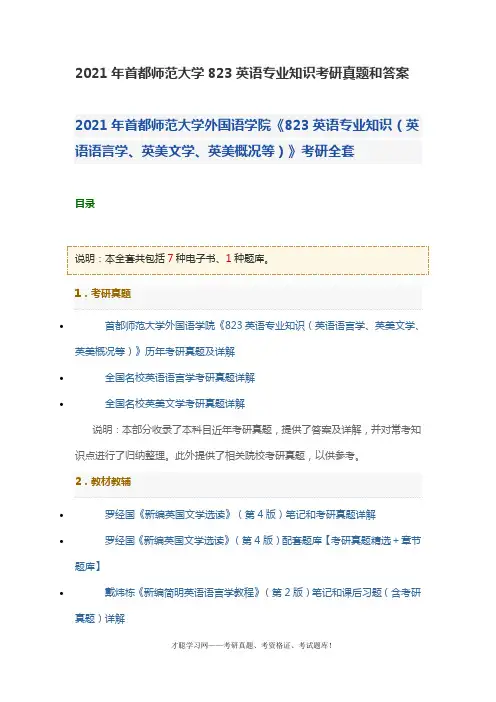
2021年首都师范大学823英语专业知识考研真题和答案2021年首都师范大学外国语学院《823英语专业知识(英语语言学、英美文学、英美概况等)》考研全套目录•首都师范大学外国语学院《823英语专业知识(英语语言学、英美文学、英美概况等)》历年考研真题及详解•全国名校英语语言学考研真题详解•全国名校英美文学考研真题详解说明:本部分收录了本科目近年考研真题,提供了答案及详解,并对常考知识点进行了归纳整理。
此外提供了相关院校考研真题,以供参考。
•罗经国《新编英国文学选读》(第4版)笔记和考研真题详解•罗经国《新编英国文学选读》(第4版)配套题库【考研真题精选+章节题库】•戴炜栋《新编简明英语语言学教程》(第2版)笔记和课后习题(含考研真题)详解•戴炜栋《新编简明英语语言学教程》(第2版)配套题库【考研真题精选+章节题库】说明:以上为本科目指定教材配套的辅导资料。
3.考研题库•2021年英美文学考研题库【名校考研真题+章节题库+模拟试题】说明:本部分为本科目考试内容的相关题库,并提供了详解。
•试看部分内容考研真题精选一、填空题1. B a co n h a s b e e n c al l e d th e f a th e r o f_____,f o r h i swo rks establi she d an d p opul ari zed in du cti ve m e tho dolo gie s fo r scien ti f ic in qui ry, o ften calle d the B aconian m ethod.(武汉大学2015研)【答案】modern science查看答案【解析】培根被称为“现代科学之父”。
2. _____ i s co n side re d th e fi rst gre at En gl i sh dram ati s tand the mo st i mportan t Eli zabeth an pl aywrigh t before Shakespe are.(北京邮电大学2016研)【答案】Chri stop her Marlowe查看答案【解析】本题考查克里斯托弗·马娄的相关知识。
618 文学理论与中国现当代文学:童庆炳主编:《文学理论教程》(第四版),高等教育出版社李建中主编:《中国古代文论》,华中师范大学出版社马新国主编:《西方文论史》(修订版),高等教育出版社钱理群等著:《中国现代文学三十年》(修订本),北京大学出版社於可训著:《中国当代文学概论》(第三版),武汉大学出版社836 中国古代文学与外国文学:袁行霈主编:《中国文学史》,高等教育出版社朱维之等主编:《外国文学简编》(第五版)(欧美部分),中国人民大学出版社2004年版梁立基等主编:《外国文学简编》(第三版)(亚非部分),中国人民大学出版社2004年版我是二战武大现当代的考生。
虽然今年成绩也不是十分地好,但总算能顺利进入武大学习了。
偶尔上论坛上看看,仍能发现不少和曾经的我一样希望能在论坛上找到一些有用信息的同学。
就想着写写自己的复习经验,权作给备考的童鞋们一些参考。
关于政治因为我是文科生,政治的基础不错,所以这个部分我并没有花费太多的时间。
2010年备考期间,我只是做了几遍北京导航2100题,看了任汝芬的序列一。
2011年备考,我还是在做2100题。
在最后一个月的时候,做了一遍历年真题。
我没有报政治补习班,个人觉得如果是文科生,完全没有必要报政治补习班。
补习班的一大误区就是会让你跟着他们学,所有的知识点都会变成可能的考试重点,并且,会让你失去主动学习的能力,总觉得跟着补习班来就会很有底气了。
当然,补习班也有不可忽略的好处,就是信息的快捷和丰富。
有条件的朋友们可以收集各个补习班的时政考点,以及冲刺班的最后几套模拟题。
最好不要偏信一个辅导班的信息,这样很可能会漏掉更重要的信息。
对于政治的学习,我个人觉得还是要看你的领悟能力和识记能力。
哲学这个部分很大程度上靠理解,理解得好记忆起来自然也就容易得多。
将一些主要的知识点背下,万变不离其宗。
近现代史和毛概是要重点识记的部分,其实也可以通过近现代史将毛概和邓论结合起来复习。
武汉大学口腔综合(352)<跨考胜经>全套考研资料第一部分历年真题及答案1-1历年考研真题。
该专业近几年学校官方不出售历年试题,最新真题更新请大家关注跨考考研论坛,真题会随时在网站更新,大家下载即可使用。
第二部分专业课笔记、讲义等内部资料2-1 口腔生物学大纲。
条理清晰,重难点突出。
打印版,共6页¥252-2 口腔生物学教案。
重难点明晰,考点全面。
电子版¥45注:以上收集资料均为本校本科生考研内部使用资料,目的是帮助跨校跨专业考生把握内部重难点,和本校考生站在同一起跑线上。
第三部分跨考专业课习题库3-1 口腔生物学习题集。
本科课后思考习题,本科期末考试题四套。
内部辅导资料,复习首选。
打印版,共6页¥30注:跨考专业课习题库的作用是强化训练,保障复习效果。
全套资料包含上述所有,套餐优惠价:¥92指定参考书目此科目没有提供参考书目适用学院/专业——基础医学院口腔基础医学(100301)——第一临床学院口腔临床医学(100302)武汉大学出版发行学(619)<跨考胜经>全套考研资料第一部分历年真题及答案1-1 历年考研真题。
包括:2001-2008年考研真题。
该专业近几年学校官方不出售历年试题,最新真题更新请大家关注跨考考研论坛,真题会随时在网站更新,大家下载即可使用。
第二部分专业课笔记、讲义等内部资料2-1 出版法治研究最新笔记。
内容详细,字迹清楚,重点突出。
手写版,共16页¥402-2 编辑实务最新笔记。
内容详细,重难点全面。
手写版,共22页¥452-3 出版发行学最新笔记。
重难点突出,条理清楚。
手写版,共17页¥40注:以上收集资料均为本校本科生考研内部使用资料,目的是帮助跨校跨专业考生把握内部重难点,和本校考生站在同一起跑线上。
第三部分跨考专业课习题库3-1 2010年考研阶段测试题及答案。
共三套,A4,打印版,共7页¥30注:跨考专业课习题库的作用是强化训练,保障复习效果。
武汉大学文学类考研备考攻略+参考书、真题一、武汉大学文学类考研参考书目(部分)1)袁行霈主编:《中国文学史》(第二版),高等教育出版社,2005年。
(第一版内容也完全一样)(2)刘勇,邹红主编:《中国现代文学史》,北京师范大学出版社,2006年。
(3)钱理群等主编:《中国现代文学三十年》(修订版),北京大学出版社,2006年。
(4)温儒敏,赵祖谟主编:《中国现当代文学专题研究》,北京大学出版社,2002年。
(5)董健,丁帆,王彬彬主编:《中国当代文学史新稿》(修订),人民文学出版社,2005年。
(6)童庆炳主编:《文学理论教程》(第四版?),高等教育出版社,2008年。
(7)童庆炳主编:《文学理论新编》(修订版),北京师范大学出版社,2005年。
(8)朱立元主编:《当代西方文艺理论》(第2版),华东师范大学出版社,2005年。
(9)李壮鹰,李春青主编:《中国古代文论教程》,高等教育出版社,2005年版。
(10)朱维之等主编:《外国文学史(欧美卷)》(第三版),南开大学出版社,2004年。
(11)郑克鲁主编:《外国文学史》(修订版),高等教育出版社,2006年。
(12)王向远:《东方文学史通论》,上海文艺出版社,2005年。
(13)王向远:《比较文学学科新论》,江西教育出版社,2006年。
二、武汉大学文学类考研专业课经验指导1.参考书的阅读方法(1)目录法:先通读各本参考书的目录,对于知识体系有着初步了解,了解书的内在逻辑结构,然后再去深入研读书的内容。
(2)体系法:为自己所学的知识建立起框架,否则知识内容浩繁,容易遗忘,最好能够闭上眼睛的时候,眼前出现完整的知识体系。
(3)问题法:将自己所学的知识总结成问题写出来,每章的主标题和副标题都是很好的出题素材。
尽可能把所有的知识要点都能够整理成问题。
2.学习笔记的整理方法(1)通过目录法、体系法的学习形成框架后,在仔细看书的同时应开始做笔记,笔记在刚开始的时候可能会影响看书的速度,但是随着时间的发展,会发现笔记对于整理思路和理解课本的内容都很有好处。
考研,说不痛苦都是假的,但其实最多的是辛苦。
下定决心准备考研是从大三结束的那个暑假开始的,所以想说:只要努力开始,一切都来得及。
在这场考试中,我确实也发挥出了最佳实力,多少也算是逆袭,成功上岸。
对于开始的过程来说谁也做不到完美,所以只能在有限时间内,争取做最有效的提升,更要关注自己不擅长的地方。
避免在不擅长的地方出现更大的问题。
话说回来,对于所有科目来说,付出与分数是成正比的,所以千万不要抱着侥幸心理去学习!一定要掌握好基础,循序渐进的努力用功才行!对于备考策略,之前从很多学长学姐经验贴里学到的再加上自己这几个月的经验,所以跟大家分享一下我的经验。
我不是什么大神级别的人,也不能够帮助自认为是学渣的孩子复习没几天就能逆袭成学神,但是我的这些经验对于跟我一样,资质普通的考生来讲应该还是有一些借鉴意义的。
首先,我不鼓励大家去经历头悬梁锥刺股的那种学习的刻苦,都什么年代了,提高学习效率的方法多的是,找到适合自己的学习方法远比头悬梁锥刺股来的让人开心。
下面就讲讲我的备考经验吧,也希望大家早日找到适合自己的学习节奏和学习方法。
篇幅总体会比较长,只因,考研实在是一项大工程,真不是一两句话可描述完的。
所以希望大家耐心看完,并且会有所帮助。
文章结尾处附上我自己备考阶段整理的学习资料,大家可以自取。
武汉大学能源动力初试科目:(101)思想政治理论(204)英语二(302)数学二(906)电路(自命题)(906)电路参考书:《电路》(第五版)邱光源高等教育出版社关于英语复习的建议考研英语复习建议:一定要多做真题,通过对真题的讲解和练习,在不断做题的过程中,对相关知识进行查漏补缺。
对于自己不熟练的题型,加强训练,总结做题技巧,达到准确快速解题的目的。
虽然准备的时间早但因为各种事情耽误了很长时间,真正复习是从暑假开始的,暑假学习时间充分,是复习备考的黄金期,一定要充分利用,必须集中学习,要攻克阅读,完形,翻译,新题型!大家一定要在这个时间段猛搞学习。
【2021年考研复试】武汉大学金融工程专业考研复试真题+经验分享复试笔试一、名词解释:远期合约价值混合证券贝塔处置效应二、简答:1,解释基差风险?如何规避基差风险?2,画图,构造蝶式价差期权。
说明什么情况下用它?3,比较系统性风险和公司特定风险?证券数目增加,两种风险会有什么变化?4,一元线性回归,分数=a+b×出勤数+u。
(1)列出u中三个影响分数的因素(2)什么条件下E(u)=0三、计算题:1.写出期权平价关系?用其阐释积木分析法和复制思想?2.考capm模型和不变增长模型。
(1)求股票期望收益率;(2)求股票理论价格;(3)问股价是否高估。
3.多元线性回归模型,给出参数估计值,给出标准差(1)求t;(2)参数显著性检验。
四、论述题:材料给出成长型股票和价值型股票的定义,特征。
(1)解释什么情况下在长期价值型股票投资业绩优于成长型股票(2)说明为什么在高度有效的市场第一问的情况不会出现。
英语面试&专业面试(一个英文自我介绍,一个英文专业课问题,两个专业课中文题,加闲聊)最后一个进场,进门说老师们下午好,老师提示就坐。
左边女老师让一分钟英语自我介绍。
然后让用英文回答基本面分析与技术分析的区别?另外一个老师让我用中文回答利率互换。
接着一个男老师面无表情的问效率与公平的看法,然后我就回答了市场自由配置,分配,福利之类的内容。
后面,老师看我是文科跨金工,问我数学,专业课自学的吗?没上课吗?我答是自学,蹭了线代等课程。
然后又问你是应届生吗?答往届生,去年考的其他学校,专业课没过线。
老师问啥学校?我答北大,自己专业课去年出了点问题,然后跟老师吐槽去年的专业课考了委托代理模型和VNM函数的综合,比平老师编的那本教材课后题难多了……。
老师说平新乔老师是北大经院的,你们怎么考那个啊?之类的闲聊然后老师说可以了可以了,复试结束了……然后我就出门了。
附面试题:英文解释期权动量交易策略三因素模型。
武汉大学MTI真题Multiple Choice (30 points, 1 point for each)1. The American approach to teaching may seem unfamiliar to many people because there is lessemphasis on learning facts than _______ true in the systems of any other countries.a) is b) it is c) it being d) to be2. Cinema-goers hate _______long queues before all cinemas.a) there being b) there to be c) there is d) there are3. _______ had a passion for walking, we started off by car.a) when b) as c) after d) while4. The opposition parties are planning to bring _______ a No-Confidence Motion against the Prime Minister.a) up b) forward c) out d) about5. India is one of the several countries which are _______ affected by widespread deforestation and steady destruction of natural watersheds.a) critically b) remarkably c) superficially d) strongly6. If you take care of the pence, the _______ will take care of themselves.a) dollars b) cents c) pounds d) money7. Over the course of centuries, the river Ganges has _______ its course many a times.a) altered b) deviated c) recovered d) adjusted8. A notable patriot and revolutionary _______ lost-to India in the death of Subhash Chandra Bose.a) was b) were c) had d) have9. The dacoits attacked the village and every man, woman and child _______ put to death.a)was b) were c) is d) are10 They tried to reassure me but I was still not able to _______ my fears.a) annul b) prevent c) reduce d) curtail11. always preferred the _______ of the big city.a) anonymity b) obscurity c) distinctiveness d) none of these12. The opposition _______ the Minister by furious criticism.a) ascribed b) hailed c) treated d) assailed13. His jokes failed to ________ even the faintest of smites from her.a) invoke b) elicit c) attract d) make14. Credit card crime is reaching _______ proportions.a) endemic b) epidemic c) unbelievable d) great15. The visitor was welcomed _______ and introduced to the Governor.a) ceremoniously b) ceremonially c) affectionately d) perfectly16. She showed great _______ and finesse in dealing with the troublesome situation.a) tact b) trick c) ability d) power17. She _______ her disapproval of the show by leaving the auditorium.a) engaged b) saw c) envisaged d) evinced18. Coaching classes often act as the _______ to success in competitive examinations.a) way b) means c) door d) window19. The poor woman has _______ many hardships after her husband died many years ago.a) born b) bore c) borne d) boar20. We partook _______ the humble meal provided by the villagers.a) with b) of c) at d) from21. This is similar to the other tune, but quite _______ from it.a) distinctive b) distinct c) diverge d) divergent22. A leading chemist believes that many scientists have difficulty with stereochemistry because much of the relevant nomenclature is _______ . in that it combines concepts that should be kept a) obscure. . . interrelated b) specialized. . . intactc) imprecise. . . discrete d) descriptive. . . separate23. A misconception frequently held by novice writers is that sentence structure mirrors thought: the more convoluted the structure, the more _______ the ideas.a) complicated b) inconsequential c) elementary d) fanciful24. A war, even if fought for individual liberty and. democratic rights, usually requires that these principles be _______ , for they are _______ the regimentation and discipline necessary for military efficiency.a) rejected. . . inherent in b) suppressed fulfilled throughc) suspended. . . incompatible with d) followed. . . disruptive of25. A number of writers who once greatly _______ the literary critic have recently recanted, substituting _______ for their former criticism.a) lauded. . . censure b) influenced. . . analysisc) simulated. . . ambivalence d) honored. . . adulation26. A human being is quite _______ creature, for the gloss of rationality that covers his or her fears and _______ is thin and often easily breached.a) a logical. . . problems b) a ludicrous. . . laughterc) a valiant. . . phobias d) an ambitious. . . morality27. The diplomat, selected for her demonstrated patience and skill in conducting such delicate negotiations, ________ to make a decision during the talks because any sudden commitment at thattime would have beena) resolved. . . detrimental b) refused. . . aproposc) declined. . . inopportune d) struggled. . . unconscionable28. Because the monkeys under study are _______ the presence of human beings, they typically _______ human observers and go about their business.a) ambivalent about . . . welcome b) habituated to . . . disregardc) pleased with . . . snub d) unaware of avoid29 He had expected gratitude for his disclosure, but instead he encountered _______ bordering on hostility.a) patience b) discretion c) indifference d) ineptitude30. Nonviolent demonstrations often create such tensions that a community that Inns constantly refused to_______ its injustices is forced to correct them: the injustices can no longer be _______ .a) acknowledge. . . ignored b) decrease. . . verifiedc) tolerate. . . accepted d) address. . . eliminated?. Reading Comprehension (40 points, 2 points for each)Read the following passages carefully and choose one best answer for each question in Passage 1, 2and 3, and answer the questions in passage 4 based on your understanding of the passage. (1) Scattered around the globe are more than one hundred regions of volcanic activity known as hot spots (hot spot: a place in the upper mantle of the earth at which hot magma from the lower mantle upwells to melt through the crust usually in the interior of a tectonic plate to form a volcanic feature; also: a place in the crust overlying a hot spot). Unlike most volcanoes, hot spots are rarely found along the boundaries of the continental and oceanic plates that comprise the Earth's crust; most hot spots lie deep in the interior of plates and are anchored deep in the layers of the Earth's surface. Hot spots are also distinguished from other volcanoes by their lavas, which contain greater amounts of alkali metals than do those from volcanoes at plate margins.In some cases, plates moving past hot spots have left trails of extinct volcanoes in much the same way that wind passing over a chimney carries off puffs of smoke. It appears that the Hawaiian Islands were created in such a manner by a single source of lava, welling up from a hot spot, over which the Pacific Ocean plate passed on a course roughly from the east toward the northwest, carrying off a line of volcanoes of increasing age. Two other Pacific island chains梩he Austral Ridge and the Tuamotu Ridge梡arallel the configuration of the Hawaiian chain; they are also aligned from the east toward the northwest, with the most recent volcanic activity near their eastern terminuses. That the Pacific plate and the other plates are moving is now beyond dispute; the relative motion of the plates has been reconstructed in. detail. However, the relative motion of the plates with respectto the Earth's interior cannot be determined easily. Hot spots provide the measuring instruments for resolving the question of whether two continental plates are moving in opposite directions or whether one is stationary and the other is drifting away from it. The most compelling evidence that a continental plate is stationary is that, at some hot spots, lavas of several ages are superposed instead of being spread out in chronological sequence. Of course, reconstruction of plate motion from the tracks of hot-spot volcanoes assumes that hot spots are immobile, or nearly so. Several studies support such an assumption, including one that has shown that prominent hot spots throughout the world seem not to have moved during the past ten million years. Beyond acting as frames Of reference, hot spots apparently influence the geophysical processes that propel the prates across the globe. When a continental plate comes to rest over a hot spot, material welling up from deeper layers forms abroad dome that, as it grows, develops deep fissures. In some instances, the continental plate may rupture entirely along some of the fissures so that the hot spot initiates the formation of a new ocean. Thus, just as earlier theories have explained the mobility of thecontinental plates, so hot-spot activity may suggest a theory to explain their mutability.1. The primary purpose of the passage is to ______ .(A) describe the way in which hot spots influence the extinction of volcanoes(B) describe and explain the formation of the oceans and continents(C) explain how to estimate the age of lava flows from extinct volcanoes(D) describe hot spots and explain how they appear to influence and record the motion of plates2. According to the passage, hot spots differ from most voicanoes in that hot spots _____ .(A) can only be found near islands(B) have greater amounts of alkali metals in their tarns(C) are situated closer to the earth's surface(D) can be found along the edges of the plates3. It can be inferred from the passage that evidence for the apparent course of the Pacific plate has been provided by the ______ .(A) configurations of several mid-ocean island chains(B) dimensions of ocean hot spotsC) concurrent movement of two hot spots(D) pattern of fissures in the ocean floor4. The passage suggests which of the following about the Hawaiian Islands, the Austral Ridge, and the Tuamotu Ridge?(A) The three chains of islands are moving eastward.(B) The three island chains are a result of the same plate movement.(C) The Hawaiian Islands are receding from the other two island chains at a relatively rapid rate.(D) The Austral Ridge and the Tuamotu Ridge chains have moved closer together whereas the Hawaiian Islands have remained stationary.5. Which of the following, if tree, would best support the author's statement that hot-spot activitymay explain the mutability of continental plates?(A) Hot spots move more rapidly than the continental and oceanic plates.(B) Hot spots are reliable indicators of the age of continental plates.(C) Hot spots are regions of volcanic activity found only in the interiors of the continental plates(D) The coastlines of Africa and South America suggest that they may once have constituted a single continent that raptured along a line of hot spots.(2)"They treat us like mules," the guy installing my washer tells me, his eyes narrowing as he wipes his hands. I had just complimented him and his partner on the speed and assurance of their work. He explains that it's rare that customers speak to him this way. I know what he's talking about. My mother was a waitress all her life, in coffee shops and fast-paced chain restaurants. It was hard work, but she liked it, liked "being among the public," as she would say. But that work had its sting too--the customer who would treat her like a servant or, her biggest complaint, like she was not that bright. There's a lesson here for this political season: the subtle and not-so-subtle insults that blue-collar and service workers endure as part of their working lives. And those insults often have to do with intelligence.We like to think of the United States as a classless society. The belief in economic mobility is central to the American Dream, and we pride ourselves on our spirit of egalitarianism. But we also have a troubling streak of aristocratic bias in our national temperament, and one way it manifests itself is in the assumptions we make about people who work with their hands. Working people sense this bias and react to it when they vote. The common political wisdom is that hot-button social issues have driven blue-collar voters rightward. But there are other cultural dynamics at play as well, And Democrats can be as oblivious to these dynamics as Republicans梩hough the Grand Old Party did appeal to them in St. Paul.Let's go back to those two men installing my washer and dryer. They do a lot of heavy lifting quickly梞ine was the first of 15 deliveries梐nd efficiently, to avoid injury. Between them there is ongoing communication, verbal and nonverbal, to coordinate the lift, negotiate the tight fit,move inrhythm with each other. And all the while, they are weighing options, making decisions and solvingproblems梐s when my new dryer didn't match up with the gas outlet.Think about what a good waitress has to do in the busy restaurant: remember orders and monitorthem. attend to a dynamic, quickly changing environment, prioritize tasks and manage the flow ofwork, make decisions on the fly. There's the carpenter using a number of mathematical concepts ymmetry proportion, congruence, the properties of angles梐nd visualizing these concepts while building a cabinet, a flight of stairs, or a pitched roof.The hairstylist's practice is a mix of technique, knowledge about the biology of hair, aesthetic judgment and communication skill. The mechanic, electrician, and plumber are troubleshooters andproblem solvers Even the routinized factory floor calls for working smarts. When has any of this madeits way into our political speeches? From either party. Even on Labor Day. Last week, the GOP masterfully invoked some old cultural suspicions: country folk versus city and east-coast versusheartland education. But these are symbolic populist gestures, not the stuff of true engagement. Judgments about intelligence carry great weight in our society, and we have a tendency to make sweeping assessments of people's intelligence based on the kind of work they do.Political tributes to labor over the next two months Will render the muscled arm, sleeve rolled tight against biceps. But few will also celebrate the thought bright behind the eye, or offer an imagethat links hand and brain. It would be fitting in a country with an egalitarian vision of itself to have atruer, richer sense of all that is involved in the wide range of work that surrounds and sustains us. Those politicians who can communicate that sense will tap a deep reserve of neglected feeling. And those who can honor and use work in explaining and personalizing their policies will find a welcome reception.6. To illustrate the intelligence of the working class, the author cites the examples of all of the following EXCEPT ______ .(A) hairstylist and waitress (B) carpenter and mechanic(C) electrician and plumber (D) street-cleaner and shop-assistant7. In the sentence "we pride ourselves on our spirit of egalitarianism" (para. 3), the word "egalitarianism" can be replaced by ______ .(A) individualism (B) enlightenment(C) equality (D) liberalism8. We can conclude from the passage that ______ .(A) in America, judgments about people's intelligence are often based on the kind of work they do(B) the subtle and not so subtle insults towards, blue-collars are a daily phenomenon in America(C) the United States is a. classless society(D) the old cultural suspicions, of country folk versus city and east-coast versus heartland education show the Republican's true engagement9. One of the major groups of targeted readers of the author should be ______ .(A) blue-collar American workers(B) middle-class American businessmen(C) American politicians(D) American company leaders10. Which of the following summarizes the main idea of the passage?(A) The Democratic Party and the Republican Party should stop symbolic populist gestures.(B) Political tributes should mind the subtle bias against the intelligence of the working class.(C) The ruling party should acknowledge the working smarts of blue-collars.(3)Joy and sadness, are experienced by people in all cultures around the world, but how can we tell when other people are happy or despondent? It turns out that-the expression of many emotions may beuniversal. Smiling is apparently a universal sign of friendliness and approval. Baring the teeth in a hostile way, as noted by Charles Darwin in the nineteenth century, may be a universe sign of anger.As the originator of the theory of evolution, Darwin believed that the universal recognition of facialexpressions would have survival value. For example, facial expressions could signal the approach ofenemies (or friends) in the absence of language.Most investigators concur that certain facial expressions suggest the same emotions in a people. Moreover, people in diverse cultures recognize the emotions manifested by the facial expressions. Inclassic research Paul Ekman took photographs of people exhibiting the emotions of anger, disgust,fear happiness, and sadness. He then asked people around the world to indicate what emotions werebeing depicted in them. Those queried ranged from European college students to members of the Fore,a tribe that dwells in the New. Guinea highlands. All groups including the Fore, who had almost nocontact with Western culture, agreed on the portrayed emotions. The For also displayed familiar facialexpressions when asked how they would respond if they were the characters in stories that called forbasic emotional responses. Ekman and his colleagues more recently obtained similar results in a studyof ten cultures in which participants were permitted to report that multipie emotions were shown byfacial expressions. The participants generally agreed on which two emotions were being shown andwhich emotion was more intense.Psychological researchers generally recognize that facial expressions reflect emotional states. In fact, various emotional states give rise to certain patterns of electrical activity in the facial muscles andin the brain. The facial-feedback hypothesis argues, however, that the causal relationship betweenemotions and facial expressions can also work in the opposite direction. According to this hypothesis,signals from the facial muscles ("feedback") are sent back to emotion centers of the brain, and so aperson's facial expression can influence that person's emotional state. Consider Darwin's words: "Thefree expression by outward signs of an emotion intensifies it. On the other hand, the repression, as faras possible, of all outward signs softens our emotions. " Can smiling give rise to feelings of good will,for example, and frowning to anger?Psychological research has given rise to some interesting findings concerning the facial-feedback hypothesis. Causing participants in experiments to smile, for example, leads them to report more positive feelings and to rate cartoons (humorous drawings of people or situations) as being more humorous. When they are caused to frown, they rate cartoons as being more aggressive.What are the possible links between facial expressions and emotion? One link is arousal, which isthe level of activity or preparedness for activity in an organism, intense contraction of facial muscles,such as those used in signifying fear, heightens arousal. Self-perception of heightened arousal thenleads to heightened emotional activity. Other links may involve changes in brain temperature and therelease of neurotransmitters (substances that transmit nerve impulses. ) The contraction of facial muscles both influences the internal emotional state and reflects it. Ekman has found that the so-calledDuchenne smile, which is characterized by "crow's feet" wrinkles-around the eyes and a subtle drop inthe eye cover fold so that the skin above the eye moves down slightly toward the eyeball, can lead topleasant feelings.Ekman's observation may be relevant to the British expression "keep a stiff upper lip" as a recommendation for handling stress. It might be that a "stiff" lip suppresses emotional response 梐slong as the lip is not quivering with fear or tension. But when the emotion that leads to stiffening thelip is more intense, and involves strong muscle tension, facial feedback may heighten emotional response.11. The word "despondent" in the passage is closest in meaning to ______ .(A) curious(B) unhappy(C) thoughtful(D) uncertain12. The author mentions "Baring the teeth in a hostile way" in order to ______ .(A) differentiate one possible meaning of a particular facial expression from other meanings of it(B) upport Darwin's theory of evolution(C) provide an example of a facial expression whose meaning is widely understood(D) contrast a facial expression that is-easily understood with other facial expressions13. The word "concur" in the passage is closest in meaning to ______ .(A) estimate(B) agree(C) expect(D) understand14. According to paragraph 2, which of the following was true of the Eore people of New Guinea?(A) They did not want to be shown photographs.(B) They were famous for their story telling skills.(C) They knew very little about Western culture.(D) They did not encourage the expression of emotions.15. According to the passage, what did Darwin believe would happen to human emotions that were not expressed?(A) They would become less intense.(B) They would last longer than usual.(C) They would cause problems later.(D) They would become more negative.(4)BANKS mimic other banks. They expose themselves to similar risks by making the same sorts of loans. Each bank's appetite for lending rises and falls in sync. What is safe for one institution becomesdangerous if they all do the same, which is-often how financial trouble starts. The scope for nasty spillovers is increased by direct linkages. Banks lend to each other as well as to customers, so one firm's failure can quickly cause others to fall over, too.Because of these connections, rules to ensure the soundness of each bank are not enough to keepthe banking system safe. Hence the calls for "macroprudential" regulation to prevent failures of thefinancial system as a whole. Although there is wide agreement that macropmdential policy is neededto limit systemic risk, there has been very little detail about how it might work. Two new reports helpfill this gap. One is a discussion paper from the Bank of England, which sketches out the elements of amacroprudential regime and identifies what needs to be decided before it is put into practice. Theother paper by the Warwick Commission, a group of academics and experts on finance from aroundthe world, advocates specific reforms.The first step is to decide an objective for macroprudential policy. A broad aim is to keep the financial system working well at all times. The bank's report suggests a more precise goal: to limit thechance of bank -failure to its "social optimum". Tempering the boom-bust credit cycle and taking some air out of asset, price bubbles may be necessary to meet these aims, but both reports agree thatshould not be the main purpose of regulation. Making finance safer is ambitious enough. Policymakers then have to decide on how they might achieve their goal. The financial system is too willing to provide credit in good times and too shy to do so in bad times. In upswings banks arekeen to extend loans because write-offs seem unlikely. The willingness of other banks to do the sameonly reinforces the trend. Borrowers seem less likely to default because with lots of credit around, thevalue of their assets is rising. As the boom gathers pace, even banks that are wary of making fresh loans carry on for fear of ceding ground to rivals. When recession hits, each bank becomes fearful ofmaking loans partly because other banks are also reluctant. Scarce credit hurts asset prices and leavesborrowers prey to the cash-flow troubles of customers and suppliers.Since the cycle is such an. -influence on banks, macroprudential regulation should make it harder for all banks to lend so freely in booms and easier for them to lend in recessions. It can do this by tailoring capital requirements to the credit cycle. Whenever overall credit growth looks too frothy, themacroprudential body could increase the minimum capital buffer that supervisors make each bankhold. Equity capital is relatively dear for banks, which benefit from an implicit state guarantee on theirdebt finance as well as the tax breaks on interest payments enjoyed by all firms. Forcing banks to holdmore capital when exuberance reigns would make it costlier for them to supply credit. It would alsoprovide society with an extra cushion against bank failures.Each report adds its own twist to this prescription. The Bank of England thinks extra capital may be needed for certain sorts of credit. If capital penalties are not targeted, it argues, banks may simplycut back on routine loans to free up capital for more exotic lending. The Warwick report says eachbank's capital should also vary with how long-lived its assets are relative to its tunding. Firms withbigmaturitiy mismatches are more likely to cause systemic problems and should be penalised. The ease ofraising cash against assets and of rolling over debt varies over the cycle, and capital rules need to reflect this. Regulators should also find ways to match different risks with the firms which can bestbear them. Ranks are the natural bearers of credit risk since they know about evaluating borrowers.Pension funds are less prone to sudden withdrawals of cash and are the best homes for illiquid assets.The Warwick group is keen that macroprudential policy should be guided by rules. if credit, assetprices and GDP were all growing above their long-run average rates, say, the regulator would be forced to step in or explain why it is not doing so. Finance is a powerful lobby. Without such a triggerfor intervention, regulators may be swayed by arguments that the next credit boom is somehow different and poses few dangers. The bank frets about regulatory capture, too, but doubts that any rulewould be right for all circumstances. It favours other approaches, such as frequent public scrutiny, tokeep regulators honest.When banks attack, no regulatory system is likely to be fail-safe. That is why Bank of England officials stress that efforts to make bank failures less costly for society must he part of regulatory reform. That includes making banks' capital structures more flexible, so that some kinds of debt turninto loss-bearing equity in a crisis. Both reports favour making systemically important banks hold extra capital, as they pose bigger risks when they fail.The Warwick group also thinks cross-border banks should abide by the rules of their host countries, so that macroprudential regulation fits local credit conditions. That would require that foreign subsidiaries be independently capitalised, which may also be necessary for a cross-border bank to have a credible "living will", a guide to its orderly resolution. This. advice will chafe most inthe European Union, where standard rules are the basis of the single market. But varying rules on capital could also be used as a macroeconomic tool in the euro area, where monetary policy cannot betailored to each country's needs. Regulation to address negative spillovers that hurt financial stabilitymight then have a positive spillover for economic stability.Answer the following questions in your own words according to the requirements. The answers should be as clear and relevant as possible.16. What is the situation facing banks and why?17. Based on your understanding of the passage, what might be the meaning of "boom-bust credit cycle" and "asset price bubbles" in the 3rdparagraph?18. How do The Bank of England and the Warwick group respond to the "macroprudential"。